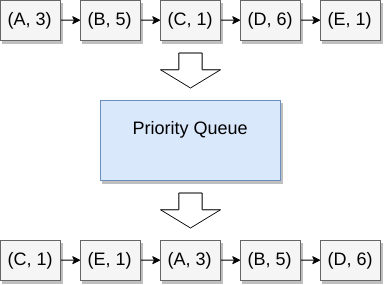


Algorithm Illustration of Dijkstra's algorithm finding a path from a start node (lower left, red) to a goal node (upper right, green) in a robot motion planning problem. Dijkstra published the algorithm in 1959, two years after Prim and 29 years after Jarník.

As a solution, he re-discovered the algorithm known as Prim's minimal spanning tree algorithm (known earlier to Jarník, and also rediscovered by Prim). A year later, he came across another problem from hardware engineers working on the institute's next computer: minimize the amount of wire needed to connect the pins on the back panel of the machine. He designed the shortest path algorithm and later implemented it for ARMAC for a slightly simplified transportation map of 64 cities in the Netherlands (64, so that 6 bits would be sufficient to encode the city number). His objective was to choose both a problem and a solution (that would be produced by computer) that non-computing people could understand. Frana, Communications of the ACM, 2001 ĭijkstra thought about the shortest path problem when working at the Mathematical Center in Amsterdam in 1956 as a programmer to demonstrate the capabilities of a new computer called ARMAC. Edsger Dijkstra, in an interview with Philip L. Eventually, that algorithm became to my great amazement, one of the cornerstones of my fame. I learned later that one of the advantages of designing without pencil and paper is that you are almost forced to avoid all avoidable complexities. One of the reasons that it is so nice was that I designed it without pencil and paper. The publication is still readable, it is, in fact, quite nice. In fact, it was published in '59, three years later. As I said, it was a twenty-minute invention. One morning I was shopping in Amsterdam with my young fiancée, and tired, we sat down on the café terrace to drink a cup of coffee and I was just thinking about whether I could do this, and I then designed the algorithm for the shortest path. It is the algorithm for the shortest path, which I designed in about twenty minutes. What is the shortest way to travel from Rotterdam to Groningen, in general: from given city to given city. In some fields, artificial intelligence in particular, Dijkstra's algorithm or a variant of it is known as uniform cost search and formulated as an instance of the more general idea of best-first search. Additionally, if preprocessing is allowed algorithms such as contraction hierarchies can be up to seven orders of magnitude faster. However, specialized cases (such as bounded/integer weights, directed acyclic graphs etc.) can indeed be improved further as detailed in Specialized variants. This is asymptotically the fastest known single-source shortest-path algorithm for arbitrary directed graphs with unbounded non-negative weights. Usually used with priority queue or heap for optimization

Mark visited (set to red) when done with neighbors. It picks the unvisited vertex with the lowest distance, calculates the distance through it to each unvisited neighbor, and updates the neighbor's distance if smaller. Dijkstra's algorithm to find the shortest path between a and b.


 0 kommentar(er)
0 kommentar(er)
